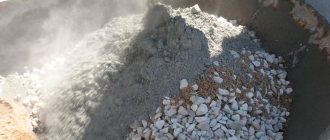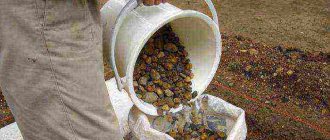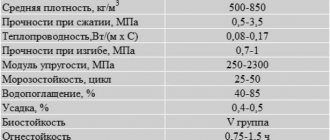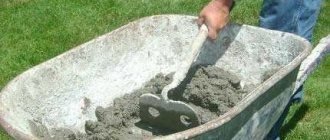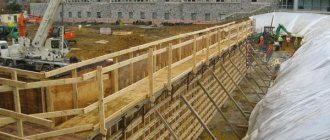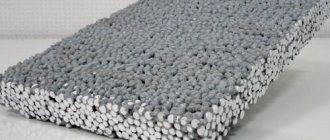2 Normative references
This standard uses regulatory references to the following interstate standards: GOST 8267-93 Crushed stone and gravel from dense rocks for construction work. Technical specifications GOST 8735-88 Sand for construction work. Test methods GOST 25584-90 Soils. Methods for laboratory determination of filtration coefficient GOST 30108-94 Construction materials and products. Determination of the specific effective activity of natural radionuclides GOST 31424-2010 Non-metallic construction materials from screenings of crushing dense rocks in the production of crushed stone. Technical conditions Note - When using this standard, it is advisable to check the validity of the reference standards in the public information system - on the official website of the Federal Agency for Technical Regulation and Metrology on the Internet or using the annual information index "National Standards", which was published as of January 1 of the current year, and according to the releases of the monthly information index “National Standards” for the current year. If the reference standard is replaced (changed), then when using this standard you should be guided by the replacing (changed) standard. If the reference standard is canceled without replacement, then the provision in which a reference is made to it is applied in the part that does not affect this reference.
3 Terms and definitions
The following terms with corresponding definitions are used in this standard:
3.1 sand:
Natural inorganic bulk material with a grain size of up to 5 mm, formed as a result of the natural destruction of rocks and obtained during the development of boulder-gravel-sand, gravel-sand and sand deposits.
3.2 enriched sand:
Natural inorganic bulk material with a grain size of up to 5 mm, with an improved grain composition and a lower content of dust and clay particles, obtained using special equipment.
3.3 fractionated sand:
Natural inorganic bulk material separated into two or more fractions using special equipment.
The essence of fractionation
The extracted sand is divided into two fractions: coarse and fine. Division occurs along the boundary grain. As a result, it turns out that instead of traditional sand, whose sizes range in a wide range (from the largest to the smallest), two types are supplied separately: large and fine.
Since the sand at its location is unevenly distributed (in terms of fraction size), the output of coarse and fine material can vary significantly. And this unpredictability can be a serious disadvantage. But there is also a significant advantage - mixing coarse and fine sand in equal proportions will allow you to achieve ideal homogeneity, which practically does not exist in natural conditions.
4 Technical requirements
4.1 Sand, enriched sand and fractionated sand must comply with the requirements of this standard and be manufactured according to technological documentation approved by the manufacturer.
4.2 Main types, parameters and dimensions
4.2.1 Depending on the grain composition (see Table 3) and the content of dust and clay particles (see Table 4), sand is divided into two classes: - class I; - class II. Depending on the grain size (fineness modulus), sand of classes I and II is divided into groups: - sand of class I - increased coarseness, large, medium and fine; - class II sand - high coarse, coarse, medium, fine, very fine, fine and very fine.
4.2.2 Each group of sand is characterized by the value of the particle size modulus Mk indicated in Table 1. Table 1
| Sand group | Size module Mk | ||||
| Increased size | St. | 3,0 | before | 3,5 | |
| Large | » | 2,5 | before | 3,0 | |
| Average | » | 2,0 | » | 2,5 | |
| Small | » | 1,5 | » | 2,0 | |
| Very small | » | 1,0 | » | 1,5 | |
| Thin | » | 0,7 | » | 1,0 | |
| Very thin | Up to 0.7 | ||||
(Amendment. IUS N 10-2015).
4.2.3 The total sand residue on sieve No. 063 must correspond to the values specified in table 2. Table 2
Percentage by weight
| Sand group | Complete residue on sieve N 063 | ||||
| Increased size | St. | 65 | before | 75 | |
| Large | » | 45 | » | 65 | |
| Average | » | 30 | » | 45 | |
| Small | » | 10 | » | 30 | |
| Very small | To 10 | ||||
| Thin | Not standardized | ||||
| Very thin | » | ||||
| Note - By agreement between the manufacturer and the consumer, in class II sand, the deviation of the total residue on sieve No. 063 from the above is allowed by no more than ±5%. | |||||
4.2.4 Content of grains in sand with a coarseness of St. 10; 5 and less than 0.16 mm should not exceed the values indicated in Table 3. For sands used in asphalt concrete mixtures, grain content less than 0.16 mm is not standardized. Table 3
Percentage by weight
| Sand class | Sand group | Grain size content | ||
| St. 10 mm | St. 5 mm | Less than 0.16mm | ||
| I | Extra fine, large and medium | 0,5 | 5 | 5 |
| Small | 0,5 | 5 | 10 | |
| II | Increased size | 5 | 20 | 10 |
| Large and medium | 5 | 15 | 15 | |
| Small and very small | 0,5 | 10 | 20 | |
| Thin and very thin | Not allowed | Not standardized | ||
4.2.5 The content of dust and clay particles in the sand, as well as clay in lumps, should not exceed the values specified in Table 4. Table 4
Percentage by weight
| Sand class | Sand group | Content of dust and clay particles | Clay content in lumps |
| I | Extra fine, large and medium | 2 | 0,25 |
| Small | 3 | 0,35 | |
| II | Extra fine, large and medium | 3 | 0,5 |
| Small and very small | 5 | 0,5 | |
| Thin and very thin | 10 | 1,0 | |
| Note - The content of dust and clay particles in very fine sand of class II, as agreed with the consumer, is allowed up to 7% by weight. | |||
4.2.6 Enriched sand is characterized by the following quality indicators: - fineness modulus; — grain composition; — content of dust and clay particles, including clay in lumps.
4.2.7 The fineness modulus of enriched sand must correspond to those given in Table 1.
4.2.8 The total balance of enriched sand on sieve No. 063 must correspond to the values given in Table 2.
4.2.9 Enriched sand in terms of grain composition must meet the requirements for class I sands of increased fineness, coarse, medium and fine, given in Table 3.
4.2.10 Fractionated sand can be produced in the following fractions (or mixtures thereof): - St. 2.5 to 5 mm; - St. 1.25 to 2.5 mm; - St. 0.63 to 1.25 mm; - St. 0.315 to 0.63 mm; - St. 0.16 to 0.315 mm. It is allowed to produce fractions of fractionated sand of other sizes or their mixtures in ratios agreed with the consumer.
4.2.11 The content of grains larger than 5 mm in fractionated sand, determined by the fraction of St. 2.5 to 5 mm, should not exceed 5% by weight.
4.2.12 The content in each fraction of fractionated sand of grains larger than the largest size and grains smaller than the smallest size should not exceed 5% by weight.
4.2.13 The content of dust and clay particles in fractionated sand should not exceed 1% by weight for the St. fraction. 2.5 to 5 mm and 1.5% for other fractions.
4.2.14 Sand, enriched sand and graded sand intended for use as aggregates for concrete must be resistant to the chemical attack of cement alkalis.
4.2.15 The maximum permissible content of harmful components and impurities in sand and the list of rocks and minerals classified as harmful components and impurities are given in Appendix A.
4.2.16 Sands when treated with a solution of sodium hydroxide (colorimetric test for determining organic impurities according to GOST 8735) should not give the solution a color that matches or is darker than the color of the standard.
4.2.17 The content of clay particles determined by the swelling method in sands used in road construction must comply with the requirements of GOST 8735. The value of the filtration coefficient is determined when testing sand according to GOST 25584.
4.2.18 Sands should not contain foreign contaminants.
4.2.19 It is allowed to supply mixtures of natural sand and sand from crushing screenings in accordance with GOST 31424 with the latter content not exceeding 20% by weight, and the mixtures must comply with the requirements of this standard.
(Amendment. IUS N 10-2015).
It is allowed to supply mixtures of natural sand and sand from crushing screenings in accordance with GOST 31424 with a content of the latter of more than 20% by weight, and the mixtures must comply with the requirements of GOST 31424. Sand from crushing screenings in the composition of mixtures having a true grain density of more than 2.8 g/cm or containing grains of rocks and minerals classified as harmful components in quantities exceeding their permissible content, or containing several different harmful components, produced for specific types of construction work in accordance with regulatory and technical documents developed in the prescribed manner and agreed with specialized in the field of corrosion laboratories.
4.2.20 The manufacturer, at the request of the consumer, must indicate the following characteristics of sand, established by geological exploration: - mineralogical and petrographic composition indicating rocks and minerals classified as harmful components and impurities; — content of organic impurities; — the true density of sand grains.
4.3 Radiation-hygienic assessment
The sand must be given a radiation-hygienic assessment, based on the results of which the area of its application is determined. Sand, depending on the specific effective activity of natural radionuclides, is used: - up to 370 Bq/kg - in newly constructed residential and public buildings; - St. 370 to 740 Bq/kg - for road construction within the territory of settlements and areas of prospective development, as well as during the construction of industrial buildings and structures; - St. 740 to 1500 Bq/kg - in road construction outside populated areas. If necessary, in national standards in force on the territory of the state, the value of the specific effective activity of natural radionuclides can be changed within the limits of the standards specified above.
Quartz sand (dry)
Construction sand
is a bulk material of inorganic nature, with a grain size from 0.15 to 5 mm, used in construction and many areas of industry. Construction sands are based on rock particles formed during their natural destruction under the influence of time and the external environment. In the form of small inclusions, they may contain clay and organic matter. Bulk density can be in the range of 1300-1500 kg/m3. Sand is a universal building material that does not cause allergic reactions and does not change the microclimate of the room. It has good fluidity, which causes the filling of all voids. Sand is fire resistant. Does not emit substances harmful to the body when exposed to fire. This is one of the most durable materials that does not change its structure over time. And also it is not subject to the process of rotting.
Price for dried sand
from 1700rub/t packaging in microfibres, from 65rub/25kg
Quartz sand
Looks beautiful, practical and reliable for a long time
Quartz sand is one of the most common natural minerals on earth and is used in many areas of human activity. This is a bulk material of sedimentary rocks, with a grain size from 0.15 to 5 mm.
The main component of quartz sand is silicon dioxide (quartz). Its formula is SiO2. Sand may also contain organic impurities, clay, oxides of iron and a number of other metals. The silicon dioxide content in the original mineral is usually at least 80-90%.
Scope of application
A huge number of areas of application of quartz sand are due to its physical, mechanical and chemical properties:
- fine sand is used in glass production
- high sorption properties make it possible to use sand in filters, filter units, water treatment plants, which are capable of purifying water from impurities, compounds of heavy metals, manganese, iron
- molding sand – one of the main components of the molding sand, used to produce cast products from steel and cast iron
- in the production of dry construction mixtures with various properties. Sand is an important component in the production of concrete, reinforced concrete products and blocks with high performance parameters
- sandblasting machines use it for cleaning, polishing or giving a matte surface to products and materials
- it is indispensable in landscape design for creating parks and garden paths, framing swimming pools from multi-colored sand of different fractions
- sand in the sandbox, this is a favorite building material for children
How are sand characteristics standardized?
The main regulatory document is GOST:
- GOST R 51641-2000 standardizes the basic requirements of sand as a filter material, granular for water purification, water treatment, etc.
- GOST 2138-91 normalizes the performance of sand for its use in molding sands
- GOST 8736-2014 standardizes the requirements for sand when used as a building material
The main parameters include
- fractional composition - a numerical expression that is the average value of particle sizes or the range of their sizes (fraction)
- clay component content
- silicon dioxide content – from 90% to 99%
- uniformity coefficient, reflecting the variation in particle sizes relative to the average (in %), i.e. the higher the value, the more homogeneous the sand mixture
- humidity - dry sands contain no more than 0.5% moisture, wet sands - no more than 4.0%, wet sands - no more than 6.0%
- metal oxide content, gas permeability, and weight loss on ignition
- increase in oxidation in solutions, increase in mass concentration in solutions
Performance properties of quartz sand
Material parameters that affect the quality of work and determine the scope of application include:
- bulk density is about 1300-1500 kg/m3
- true density is in the range of 2600-2700 kg/m3. The true density value is used when calculating the volume of cement or concrete mortar obtained by mixing the components
- The thermal conductivity of quartz sand is about 0.39 W/(m.h.°C). The shape and size of sand granules have a significant impact on the heat-insulating properties - the denser their arrangement and the smaller the gaps, the higher the thermal conductivity coefficient
- melting point - the maximum working temperature of quartz sand is estimated at 1050 °C, which is quite sufficient for any construction work
- hardness on the Mohs scale – 7 units
- chemically resistant – does not enter into chemical reactions with other substances
- removes iron, manganese, chlorine and aluminum from water
- reduces the amount of radionuclides
- sorbs ions of heavy metals: cesium, lead, iron, copper and cadmium
- removes pesticides, nitrates and dioxins
- fights bacteria and viruses
- neutralizes fungus, parasites and algae
The production technologies of our company allow us to produce almost the entire range of fractions of quartz sand - from 0.1 mm to 5.0 mm, as well as quartz grains and stone up to 10-15 mm. The moisture content of the sand in the finished product is no more than 0. 2%
The quality of the sand is confirmed by tests carried out in accredited laboratories
You can order quartz sand in the quantities you need and get advice on products by calling +7 951-78-62-914, sales specialist Alexey
Products, at the request of the client, can be packaged in 25 kg bags; shipment in MKR (Big Bag) bags with a carrying capacity of 1 ton is possible. We can also consider other packaging options.
Certificate
Application for dry sand
5 Acceptance rules
5.1 Sand, enriched sand and graded sand must be accepted by the technical control service of the manufacturer.
5.2 To verify compliance of the quality of sand, enriched and fractionated sand with the requirements of this standard, acceptance control and periodic tests are carried out.
5.3 Acceptance control at the manufacturer is carried out daily by testing a combined replacement sand sample selected in accordance with GOST 8735. During acceptance control, the following is determined: - grain composition; — content of dust and clay particles; — clay content in lumps; — presence of clogging impurities.
5.4 During periodic testing of sands, the following is determined: - once a quarter, bulk density (bulk density at humidity during shipment is determined if necessary) and the presence of organic impurities (humic substances); - once a year and with each change in the properties of the rock being mined, the true density of grains, the content of rocks and minerals classified as harmful components and impurities, the specific effective activity of natural radionuclides. Periodic monitoring of the specific effective activity of natural radionuclides is carried out in specialized laboratories duly accredited for the right to conduct gamma spectrometric tests or in radiation metric laboratories of supervisory authorities. In the absence of geological survey data on the radiation-hygienic assessment of the deposit and a conclusion on the class of sand, the manufacturer carries out a radiation-hygienic assessment of the mined rock sections using the express method directly at the mine face or in finished product warehouses (according to the alluvium map) in accordance with the requirements of GOST 30108 .
5.5 Acceptance and delivery of sand, enriched sand and fractionated sand is carried out in batches. A batch is considered to be the amount of sand established in the supply contract and simultaneously shipped to one consumer in one train or in one vessel. When shipping by road, a batch is considered to be the amount of sand shipped to one consumer per day.
(Amendment. IUS N 10-2015).
5.6 Selection and preparation of sand samples for quality control at the manufacturing plant is carried out in accordance with the requirements of GOST 8735.
5.7 When checking the quality of sand, the consumer must use the sampling procedure given in 5.8-5.11. If the results of the control check on the grain composition, the content of dust and clay particles and clay in lumps are unsatisfactory, the batch of sand will not be accepted.
5.8 The number of spot samples taken to control the quality of sands in each tested batch, depending on the volume of the batch, must be at least:
| with batch size | 350 m | 10; |
| St. 350 to 700 m | 15; | |
| St. 700 m | 20. |
From the spot samples, a combined sample is obtained that characterizes the controlled batch. Averaging, reduction and sample preparation are carried out according to GOST 8735.
5.9 To control the quality of sand shipped by rail, spot samples are taken when unloading cars from the flow of sand on belt conveyors used to transport it to the consumer’s warehouse. When unloading the car, five spot samples are taken at equal time intervals. The number of cars is determined taking into account the receipt of the required number of spot samples in accordance with 5.8. Cars are selected according to the instructions of the consumer. If the batch consists of one wagon, five spot samples are taken during unloading, from which a combined sample is obtained. If conveyor transport is not used for unloading, spot samples are taken directly from the cars. To do this, the surface of the sand in the car is leveled and holes 0.2-0.4 m deep are dug at the sampling points. The sampling points should be located in the center and in the four corners of the car, and the distance from the sides of the car to the sampling points should be not less than 0.5 m. Samples are taken from the holes with a scoop, moving it from bottom to top along the walls of the hole.
5.10 To control the quality of sand supplied by water transport, spot samples are taken when unloading ships. When belt conveyors are used for unloading, point samples are taken at regular intervals from the flow of sand on the conveyors. When unloading a vessel with grab cranes, point samples are taken with a scoop at regular intervals as unloading proceeds, directly from the newly formed sand surface in the vessel, and not from the holes. For control testing of sand unloaded from ships and placed on alluvial maps using hydromechanization, spot samples are taken in accordance with GOST 8735, paragraph 2.9.
5.11 To control the quality of sand shipped by road transport, spot samples are taken when unloading vehicles. If belt conveyors are used for unloading sand, point samples are taken from the flow of sand on the conveyor. When unloading each vehicle, one spot sample is taken. The number of cars is determined taking into account the receipt of the required number of spot samples according to 5.8. Cars are selected according to the consumer's instructions. If the lot consists of less than ten cars, sand samples are taken from each car. If conveyor transport is not used when unloading cars, spot samples are taken directly from the cars. The surface of the sand in the car is leveled, a hole 0.2-0.4 m deep is dug in the center of the body. Sand samples are taken from the hole with a scoop, moving it from bottom to top along the wall of the hole.
5.12 The quantity of sand supplied is determined by volume or weight. Sand measurements are carried out in wagons, ships or cars. Sand shipped in wagons or cars is weighed on truck scales. The mass of sand shipped in ships is determined by the vessel's draft. The amount of sand from units of mass to units of volume is recalculated based on the bulk density of sand, determined by its moisture content during shipment. The supply contract specifies the calculated sand moisture content accepted by agreement of the parties.
5.13 The manufacturer must accompany each batch of supplied sand with a quality document, which indicates: - the name of the manufacturer and its address; — number and date of issue of the document; — name and address of the consumer; — batch number, name and quantity of material; — numbers of invoices and vehicles; — grain composition of sand, enriched sand; — grain composition of a mixture of fractions or the size of narrow fractions (for fractionated sand); — content of dust and clay particles, clay in lumps; — content of harmful components and impurities; — presence of clogging impurities; — bulk density and filtration coefficient (at the consumer’s request) in sand and enriched sand; — specific effective activity of natural radionuclides; — designation of this standard.
Molding sand
To check the compliance of the quality of molding sands with the requirements of this standard, at least 8 spot samples weighing at least 0.5 kg are taken from each batch. If unsatisfactory test results are obtained for at least one of the indicators, repeated tests are carried out for this indicator on a combined sample of double mass taken from the same batch. The results of repeated tests are applied to the entire batch.
General requirements for test methods, selection and preparation of samples for testing - according to GOST Determination of the mass fraction of the clay component - according to GOST Determination of the mass fraction of silicon dioxide - according to GOST Determination of the uniformity coefficient and average grain size - according to GOST Determination of the ultimate compressive strength in a wet state - according to GOST Determination of the mass fraction of moisture - according to GOST Determination of the mass fraction of iron oxide - according to GOST Determination of the mass fraction of calcium oxide - according to GOST Determination of the mass fraction of magnesium oxide - according to GOST Determination of the mass fraction of potassium and sodium oxides - according to GOST The batch is considered to be the amount of sand established in supply agreement and simultaneously shipped to one consumer on one train or on one vessel.
When shipping by road, a batch is considered to be the amount of sand shipped to one consumer per day. If the results of the control check on the grain composition, the content of dust and clay particles and clay in lumps are unsatisfactory, the batch of sand will not be accepted.
From the spot samples, a combined sample is obtained that characterizes the controlled batch.
Sand for construction works. ISS Introduction date The goals, basic principles and basic procedure for work on interstate standardization are established by GOST 1. Interstate standards, rules and recommendations for interstate standardization.
Averaging, reduction and sample preparation are carried out in accordance with GOST. When unloading the car, five spot samples are taken at equal time intervals. The number of cars is determined taking into account the receipt of the required number of spot samples in accordance with 5. The cars are selected according to the instructions of the consumer.
Quartz sands for the filter layer of water purification filters
If the batch consists of one wagon, five spot samples are taken during unloading, from which a combined sample is obtained. If conveyor transport is not used for unloading, spot samples are taken directly from the cars.
To do this, the surface of the sand in the car is leveled and holes with a depth of 0.4 m are dug at the sampling points. The sampling points must be located in the center and in the four corners of the car, and the distance from the sides of the car to the sampling points must be at least 0 .5 m. Samples are taken from the holes with a scoop, moving it from bottom to top along the walls of the hole.
When belt conveyors are used for unloading, point samples are taken at regular intervals from the flow of sand on the conveyors.
6 Test methods
6.1 Sand tests are carried out in accordance with GOST 8735.
6.2 The filtration coefficient of sand and enriched sand used in road construction is determined according to GOST 25584.
6.3 The content of clay particles in sand used in road construction by swelling is determined according to GOST 8735.
6.4 The specific effective activity of natural radionuclides is determined according to GOST 30108.
6.5 The resistance of sands to harmful components and impurities is determined according to GOST 8735 based on the mineralogical and petrographic composition and the content of harmful components and impurities.
7 Transportation and storage
7.1 Transportation
7.1.1 Sand, enriched sand and fractionated sand are transported by rail, water and road transport in accordance with the rules for the carriage of goods in force for a particular type of transport.
7.1.2 Dry fractionated sand is transported in the form of separate fractions or mixtures thereof using specialized vehicles (cement trucks, capsules and other means of transportation that provide protection from moisture and the ingress of contaminants). The permissible moisture content of sand is set by the consumer, and the range of permissible moisture content should be in the range from 0.1% to 0.5% by weight, unless a different value is specified in other regulatory documents.
7.2 Storage
7.2.1 Sand and enriched sand are stored in the warehouse of the manufacturer and consumer under conditions that protect them from contamination.
7.2.2 Dry fractionated sand should be stored in dry indoor areas or closed bunkers (silos) that prevent the ingress of moisture and contaminants.
7.2.3 When shipping and storing sand and enriched sand in winter, the manufacturer should take measures to prevent freezing (shovelling, treatment with special solutions, etc.).
Washing sand and crushed stone in combination with a screen and irrigation
A screen with irrigation does not have a fundamental difference in design compared to a conventional screen, but in fact, a washing screen requires higher quality manufacturing, the use of steel with corrosion protection (stainless or special coatings). Irrigation is created using a system of nozzles installed above the screen, through which water is supplied to the upper sieve and the material on it.
| Advantages | Flaws |
| high feed size (up to 250 mm); effective separation into specified fractions determined by replaceable meshes; sufficiently high-quality flushing from dust and clay inclusions; relatively small dimensions with high solids productivity (up to 300 m3/h with installation size (LxWxH) 8x3.5x5 m, drive power about 30 kW); reasonable water consumption (up to 300-450 m3/h at maximum productivity) - 1-1.5 parts water to 1 part solid | high-quality cleaning only for a small content of clay inclusions and dust for crushed material; subsequent washing and dewatering of the sand is required. |
The effective size of separation into drain and coarse depends on the installed bottom mesh and is in the range: 2-8 mm.
Appendix A (mandatory). Permissible content of harmful components and impurities
Appendix A (mandatory)
The permissible content of rocks and minerals classified as harmful components and impurities in sand used as a filler for concrete and mortars should not exceed the following values: - amorphous varieties of silicon dioxide, soluble in alkalis (chalcedony, opal, flint, etc.) , - no more than 50 mmol/l; - sulfur, sulfides, except pyrite (marcasite, pyrrhotite, etc.), and sulfates (gypsum, anhydrite, etc.) in terms of - no more than 1.0%; pyrite in terms of - no more than 4% by weight; — mica — no more than 2% by weight; - halogen compounds (halite, sylvite, etc.), including water-soluble chlorides, in terms of chlorine ion - no more than 0.15% by weight; — coal — no more than 1% by weight; - organic impurities (humic acids) - less than the amount that gives the sodium hydroxide solution (colorimetric test according to GOST 8267) a color corresponding to the color of the standard or darker than this color. The use of sand that does not meet this requirement is permitted only after positive results have been obtained from tests of sand in concrete or mortar for durability characteristics. The permissible content of zeolite, graphite, and oil shale is established based on studies of the effect of sand on the durability of concrete or mortar.
